Let's talk Standard Long-Haired Dachshunds
It’s no exaggeration to say the Standard Long-Haired Dachshund is dogged in their pursuit of all things: Part of the Scent Hound group, the breed is celebrated for their compact size. How could a dog this tiny, you wonder, catch anything? But the Dachshund dog was bred small for sport, specifically to burrow into the narrow earth to find badgers and the most wee animals. A background like this gave rise to their brave, take-no-prisoners attitude. As if their unique size weren’t enough, Dachshunds come in a miniature version as well.
Official name: Standard Long-Haired Dachshund
Other names: Doxie, Dashie, Badger Dog
Origins: Germany
Drooling tendencies
1 out of 5Grooming needs
4 out of 5Shedding Level
3 out of 5Barking tendencies
3 out of 5Energy level (high, low, medium)*
3 out of 5Compatibility with other pets
2 out of 5Warm weather?
3 out of 5Cold weather?
1 out of 5Suited to apartment living
3 out of 5Can stay alone
3 out of 5Family pet?*
2 out of 5
| Male | Female |
|---|---|
| Height | Height |
| 37 - 47 cm | 35 - 45 cm |
| Weight | Weight |
| 9 - 12 kg | 9 - 12 kg |
| Life Stage | |
|---|---|
| Puppy | Adult |
| 2 to 10 months | 10 months to 8 years |
| Mature | Senior |
| 8 to 12 years | From 12 years |
Drooling tendencies
1 out of 5Grooming needs
4 out of 5Shedding Level
3 out of 5Barking tendencies
3 out of 5Energy level (high, low, medium)*
3 out of 5Compatibility with other pets
2 out of 5Warm weather?
3 out of 5Cold weather?
1 out of 5Suited to apartment living
3 out of 5Can stay alone
3 out of 5Family pet?*
2 out of 5
| Male | Female |
|---|---|
| Height | Height |
| 37 - 47 cm | 35 - 45 cm |
| Weight | Weight |
| 9 - 12 kg | 9 - 12 kg |
| Life Stage | |
|---|---|
| Puppy | Adult |
| 2 to 10 months | 10 months to 8 years |
| Mature | Senior |
| 8 to 12 years | From 12 years |

Get to know the Standard Long-Haired Dachshund
All you need to know about the breed
The Standard Long-Haired Dachshund is one breed that’s easy to have around. An unruffled demeanor and tons of energy means they’re up for any game you propose. Repeatedly. You’ll always find the affectionate Dachshund right by your side. They are known to be warmhearted. And the Standard Long-Haired Dachshund’s lifespan of anywhere from 12 to 16 years means a lot of together-time.
As energetic as they are, this is one breed that’s never going to be a marathon buddy. Small jaunts around the block each day are enough to keep both little legs and a long body fit.
There are three Dachshund coat types: the Wire-Haired, the Smooth-Haired, and the Long-Haired. There are three Dachshund sizes, too: Miniature, Standard, and Kaninchen. The latter has a wider chest - measured at 11.8 inches - and a weight of no more than 7.7lbs. Kaninchen translates from German as “rabbit”, the size developed specifically to burrow and hunt rabbits or other small animals. Lovers of the breed commonly call weights between 11 and 16lbs “tweenies.” However, this category is not recognised by any official kennel club.
The Dachshund dog tends to be an independent spirit but they are not at all aloof. Conversely, they very much bond with one person. It’s important to train your Standard Long-Haired Dachshund correctly to ensure they are as social as possible and to prevent any nipping at strangers. With their legacy as a field sport dog, Standard Long-Haired Dachshunds possess a tenacious streak; crate training can help when necessary.
When it comes to work, this is a breed that likes to have a job, and doesn’t mind helping you with yours. They are characteristically courageous and, ironically, have a big bark - even sounding like a big dog - for such a little breed.
Standard Long-Haired Dachshunds should be kept warm as their small bodies don’t hold up to the cold. Canine-appropriate winter gear can be a good idea. And Dachshunds can certainly pull it off.
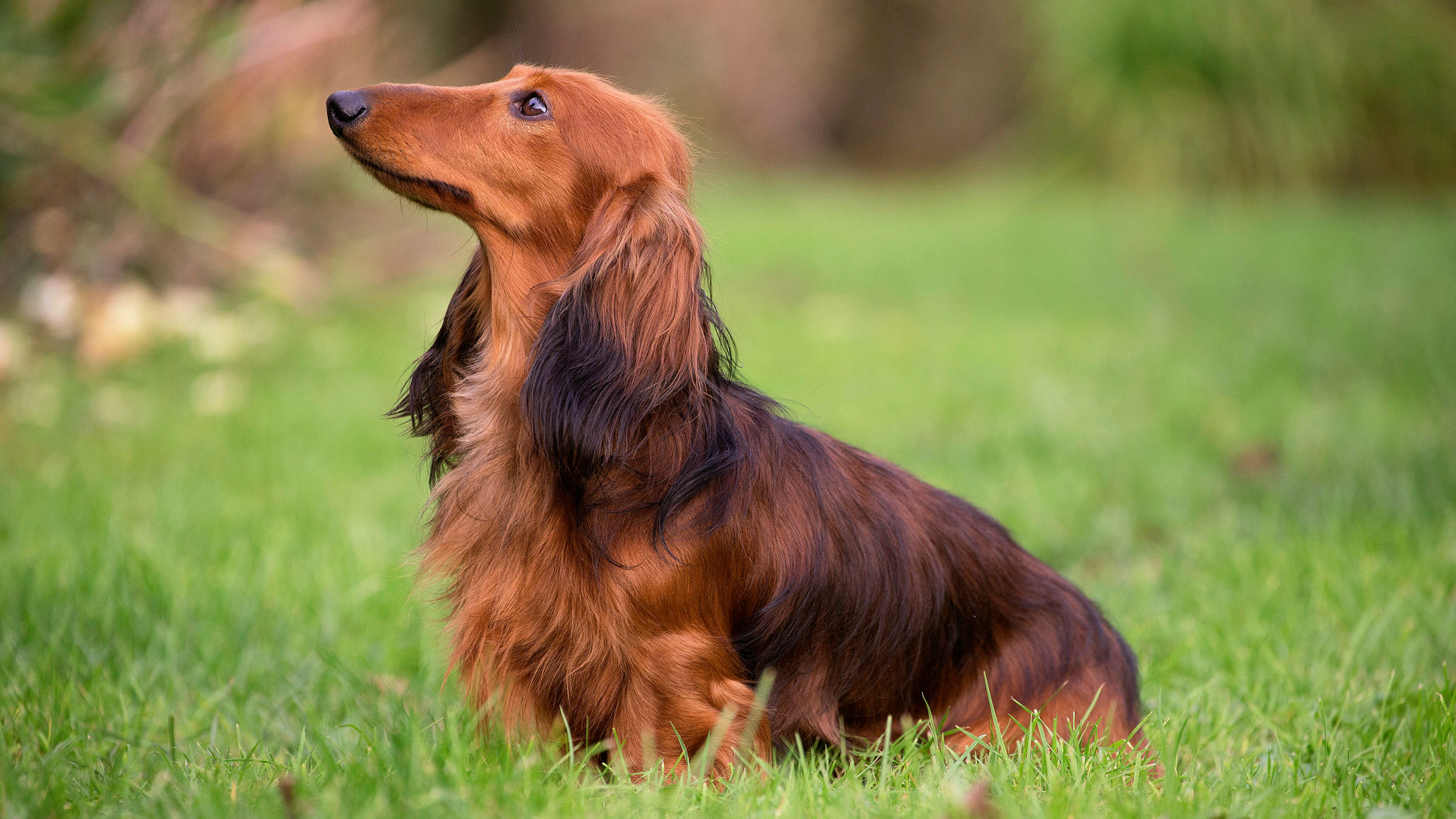
Two facts about Standard Long-Haired Dachshunds
1. Dachshunds can be suspicious of strangers
A sweet breed, the Standard Long-Haired Dachshund personality is one that’s standoffish, especially when newcomers arrive, given their ability to attach to one person so strongly. Socialise your dog early so they fully develop their affable side.
2. Two for one: A small size and big bark
Despite their diminutive dimensions, Standard Long-Haired Dachshunds have a huge bark, a result of their role in trapping: After burrowing deep into the earth for prey, the bellow alerts hunters above that they might have found something interesting below.
History of the breed
The Standard Long-Haired Dachshund ancestry is a rich one emanating from Germany, where they are a source of national pride. A quintessential field sport dog, the breed is a member of the Hound Group bred from the German Bassett over six centuries. The German Dachshund Club was formed in 1888, and the Dachshund became a member in the American Kennel Club studbook in 1885.
For a small breed, they have a very loud bark that makes them sound like a much bigger dog. The distinctive Standard Long-Haired Dachshund bark developed due to their role as a field sport dog, to notify hunters above ground where the dog was when down below burrowing for prey. Often used in packs to hunt much bigger animals, like wild boar, their determined nature worked in their favour.
With anti-German sentiment rising after World War II, American fans of the friendly Dachshund breed changed their name to Liberty Hounds for some time. Luckily, it never took. The Dachshund eventually developed into the national symbol of Germany. The even-tempered breed has now become cherished the world over.
From head to tail
Physical characteristics of Standard Long-Haired Dachshunds
1.Ears
2.Head
3.Body
4.Fur
5.Tail
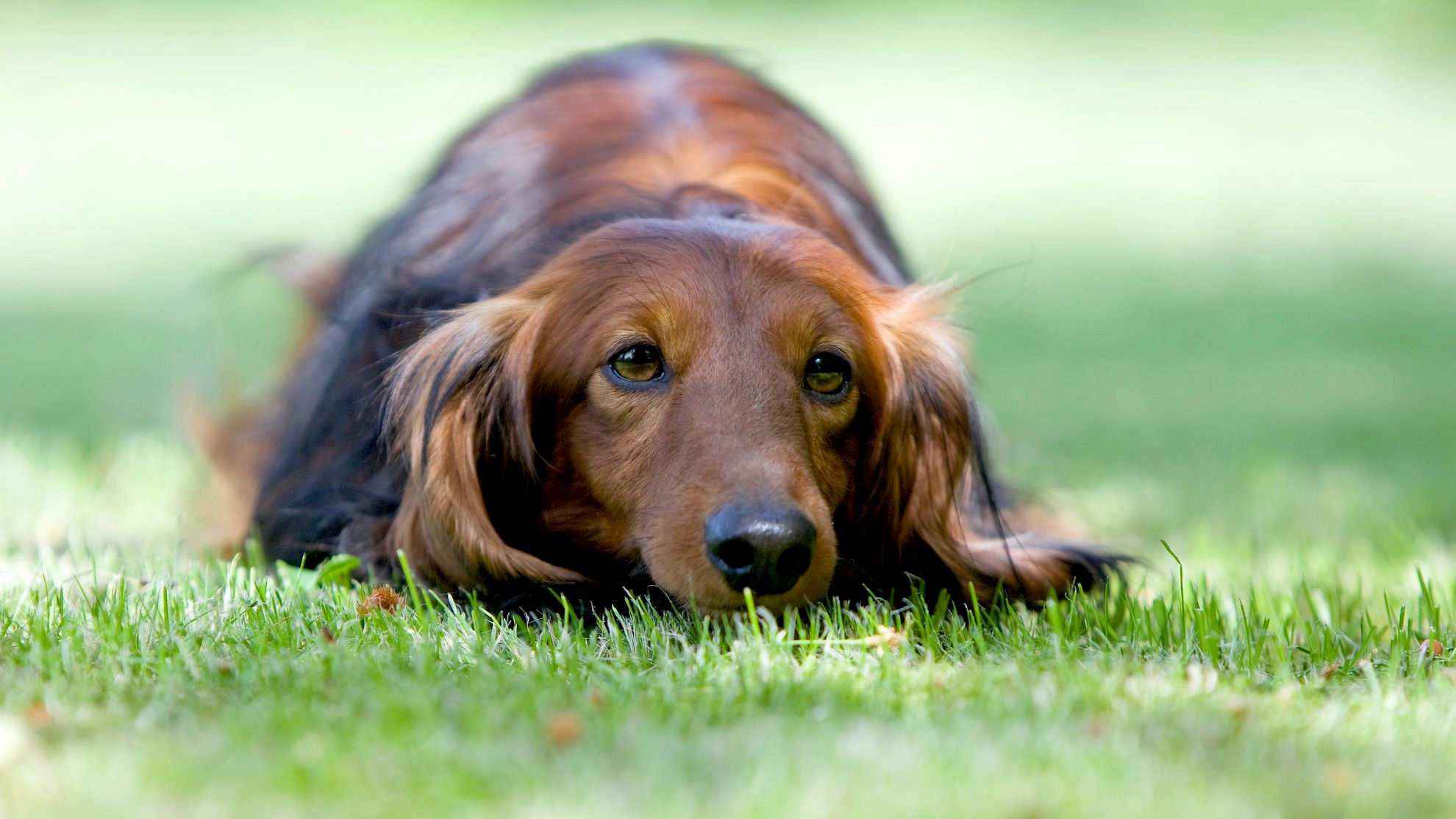
Things to look out for
From specific breed traits to a general health overview, here are some interesting facts about your Standard Long-Haired Dachshund
Don’t let your Dachshund jump too much
Take care to prevent your Standard Long-Haired Dachshund from seemingly normal or athletic movements - like jumping from furniture or climbing staircases. These may sound harmless enough but the Standard Long-Haired Dachshund can easily injure their long backs since their short legs can’t support the lengthy torso. Keep an eye on your dog so he doesn’t make any moves that might wreak havoc on him physically. Regular exercise will keep their back strong and their legs, too.
Likes to hunt and dig
Standard Long-Haired Dachshunds were bred for the field, the prototypical sport dog, so it is, at times, hard to shake in-bred traits - like digging. While at home, it may be the case that your dog bores through plants, the garden, or even laundry and personal belongings, just to satisfy this innate drive. Their small legs were perfectly designed to handle this task, along with super-sharp claws and teeth. Due to their innate desire to please, they can be trained to tone down this tendency. Doing so early will best instill great manners in your dog.
Prone to epilepsy
The Standard Long-Haired Dachshund is a healthy dog but the breed can be prone to epileptic seizures. The cause of the condition is genetic and is a chronic neurological disorder, characterized by jerking, shaky movements, and muscle twitching. Epileptic seizures start with little-to-no warning and are usually short-lived, and end on their own. Stay calm during a seizure since they are over fairly quickly, more often than not, and your dog is not normally aware of the problem as it happens. Pay close attention when it does, so you can communicate information on your Standard Long-Haired Dachshund to your veterinarian. As with all illnesses, early detection is key and regular vet checkups will help monitor the situation. Epilepsy can usually be controlled with medication.
Healthy diet, healthier dog
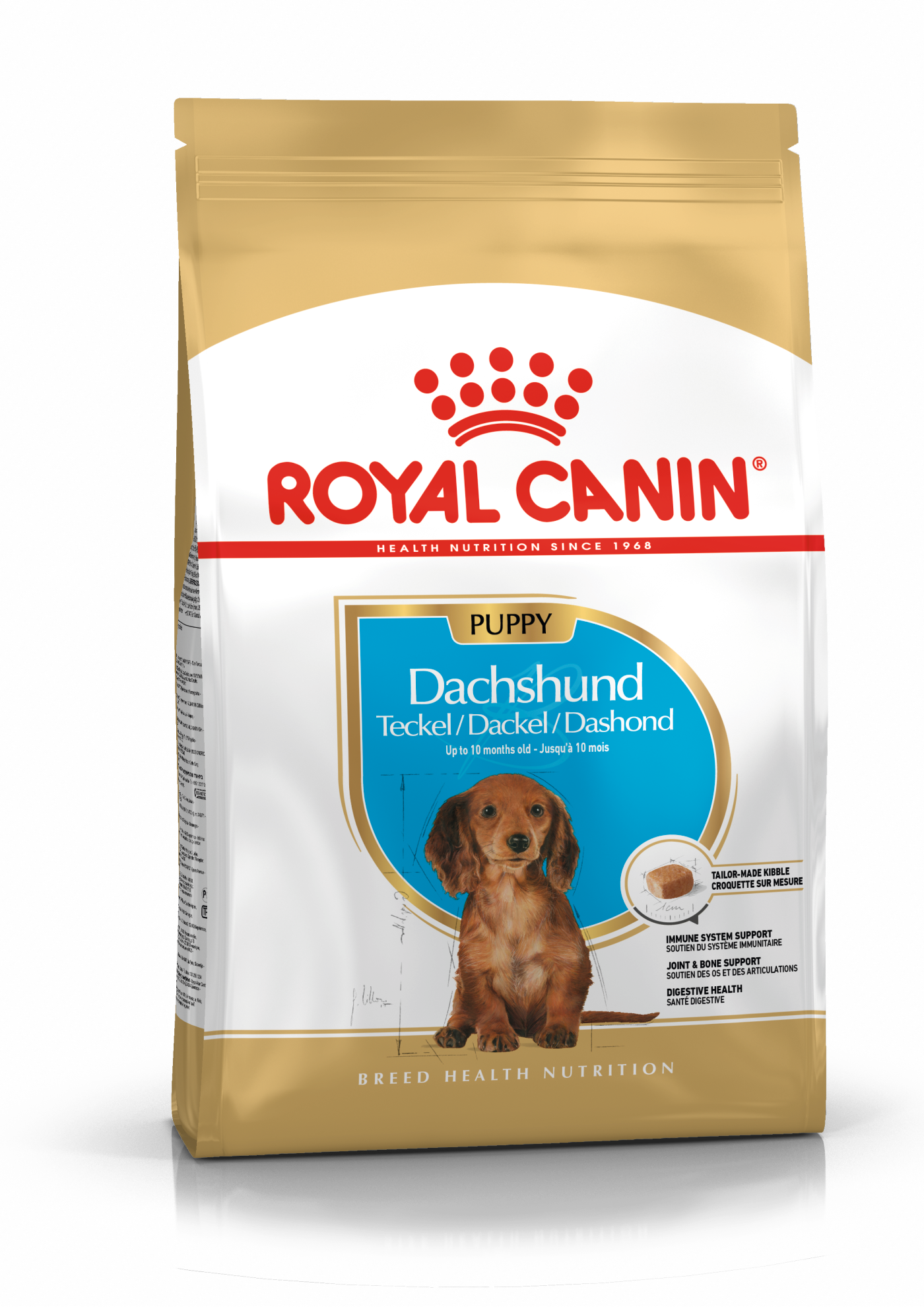
When choosing food for a Dachshund, there are many factors to consider: their age, lifestyle, activity level, physiological condition and health, including potential sickness or sensitivities. Food provides energy to cover a dog’s vital functions and a complete nutritional formula should contain an adjusted balance of nutrients to avoid any deficiency or excess in their diet, both of which could have adverse effects on the dog.
Clean and fresh water should be available at all times to support your dog’s urinary health. In hot weather and especially when out exercising, bring water along and give your dog frequent water breaks.
The following recommendations are for healthy animals. If your dog has health problems, please consult your veterinarian who will prescribe an exclusive veterinary diet.
A Dachshund puppy’s requirements, in terms of energy, protein, minerals and vitamins, are much greater than those of an adult dog. They need energy and nutrients to maintain their body, as well as to grow and build new cells. Until they are 10 months old, a Dachshund puppies’ immune system develops gradually. A complex of antioxidants, including vitamin E, can help to support their natural defences during this time of big changes, discoveries and new encounters. Their digestive functions are different from an adult Dachshund’s, too: their digestive system is not mature yet so it’s important to provide highly digestible proteins that will be effectively used. Prebiotics, such as fructo-oligosaccharides, support digestive health by helping balance the intestinal flora, resulting in good stool.
Similarly, a puppy’s teeth – starting with the milk teeth, or first teeth, then the permanent teeth – are an important factor that needs to be taken into account when choosing the size, form, and hardness of kibble. This intense growth phase also means high energy needs, so the food must have a high energy content (expressed in Kcal/100g of food), while concentrations of all other nutrients will also be carefully adapted, especially calcium and phosphorus content that supports the Dachshund puppy’s bones and joints. It is recommended to split the daily allowance into three meals until they are six months old, then to switch to two meals per day.
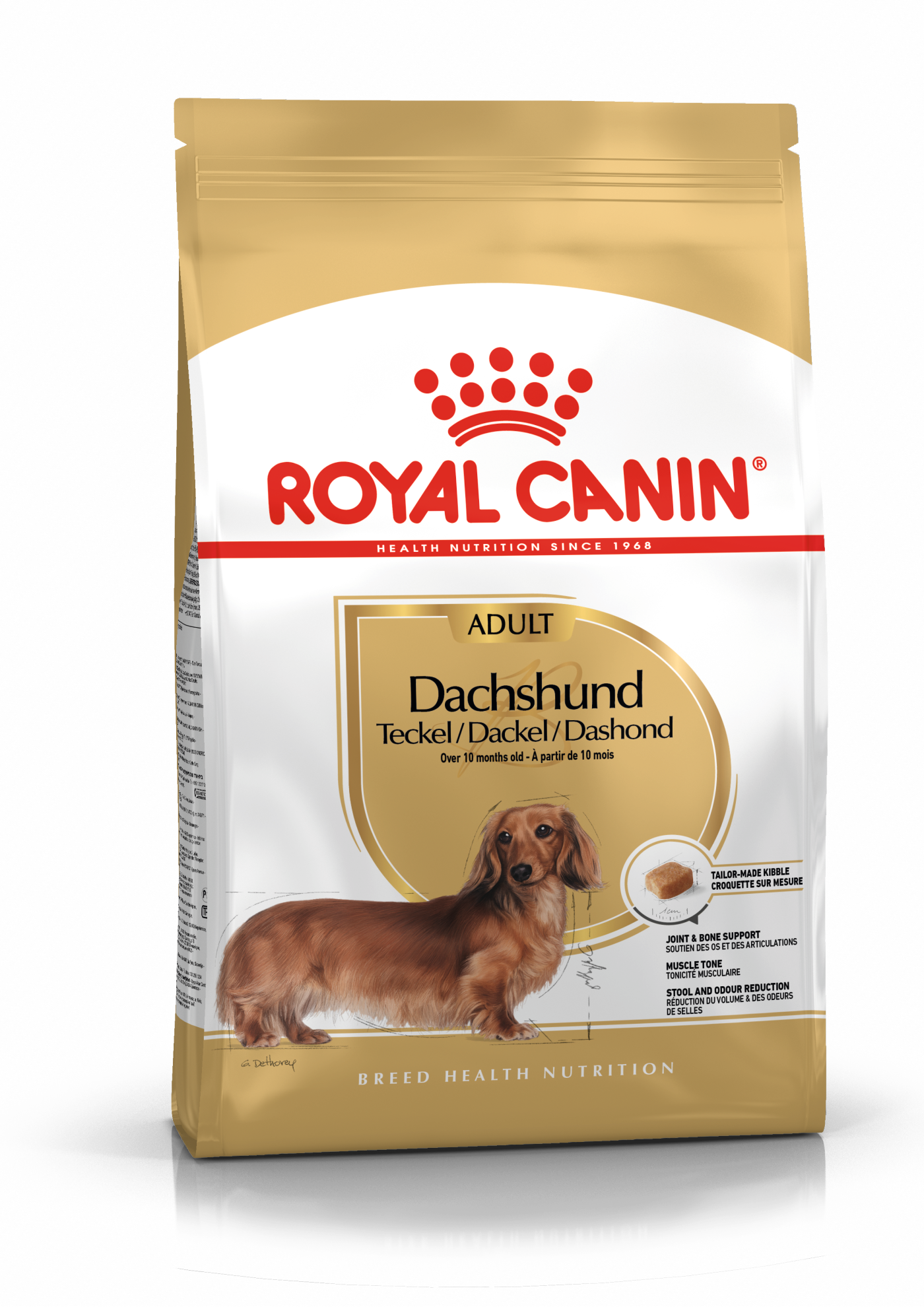
The main nutritional goals for adult Dachshunds are:
Supporting bones and joints with an adjusted calcium and phosphorus content as well as nutrients such as glucosamine and chondroitin.
Maintaining muscle tone and an ideal body weight by using highly digestible ingredients and keeping the fat content at a sensible level.
Preserving the health and beauty of the skin and coat with the enriched addition of essential fatty acids (especially EPA-DHA), essential amino acids, and B vitamins.
At adult age, small breed dogs are exposed to oral and dental disorders, more precisely, accumulation of dental plaque and tartar. The Dachshund’s teeth and jaws need a lot of protection. A special kibble shape and a texture designed to promote chewing can help in slowing down the formation of dental plaque, and a formula containing calcium chelators can help reduce tartar formation, hence helping to support daily oral hygiene. Small breed dogs are well known for being fussy eaters. Exclusive formula and flavourings, as well as a kibble size with a special texture, will stimulate their appetite. Small breed dogs are prone to urinary stones; a diet that supports a healthy urinary system is recommended to prevent urinary stones.
For Dachshunds living mainly indoors, highly digestible proteins, an appropriate fibre content, and very high quality carbohydrate sources will help reduce faecal smell and volume. Because an indoor lifestyle often means less exercise, an adapted calorie content, which meets the reduced energy needs, and a diet that contains L-carnitine, which promotes fat metabolism, can help maintain an ideal weight. It is important to avoid feeding them human foods or fatty snacks. Instead, reward your dog with kibble taken from their daily meal allowance, and strictly follow the feeding guidelines written on the package in order to prevent excessive weight gain.

Similarly, a puppy’s teeth – starting with the milk teeth, or first teeth, then the permanent teeth – are an important factor that needs to be taken into account when choosing the size, form, and hardness of kibble. This intense growth phase also means high energy needs, so the food must have a high energy content (expressed in Kcal/100g of food), while concentrations of all other nutrients will also be carefully adapted, especially calcium and phosphorus content that supports the Dachshund puppy’s bones and joints. It is recommended to split the daily allowance into three meals until they are six months old, then to switch to two meals per day.
Higher vitamin C and E content. These nutrients have antioxidant properties, helping to protect the body’s cells against the harmful effects of the oxidative stress linked to ageing.
EPA-DHA and precise levels of calcium and phosphorus to support the Dachshund’s bones and joints. Dachshunds have short limbs and vertebrae so tend to have more mechanical joint stress compared to other breeds.
Adjusted nutrients and calories compared to an adult diet to help maintain the ideal weight of the maturing Dachshund. Excess weight gain can affect the health of the Dachshund, so an appropriately balanced diet is necessary to maintain optimal health.
High-quality protein. Contrary to a widely held misconception, lowering the protein content in food brings little benefit in limiting kidney failure. In addition, older dogs are less efficient at using dietary protein than younger dogs. Reducing the phosphorus content is a good way of slowing down the gradual deterioration of kidney function.
A higher proportion of the trace elements iron, zinc and manganese to maintain good condition of the skin and coat
As they age, dogs increasingly suffer from teeth problems. To ensure they continue to eat in sufficient quantities, the shape, size, and hardness of their kibble needs to be tailored to their jaw. Kibbles may be softened with warm water to allow for easier eating.
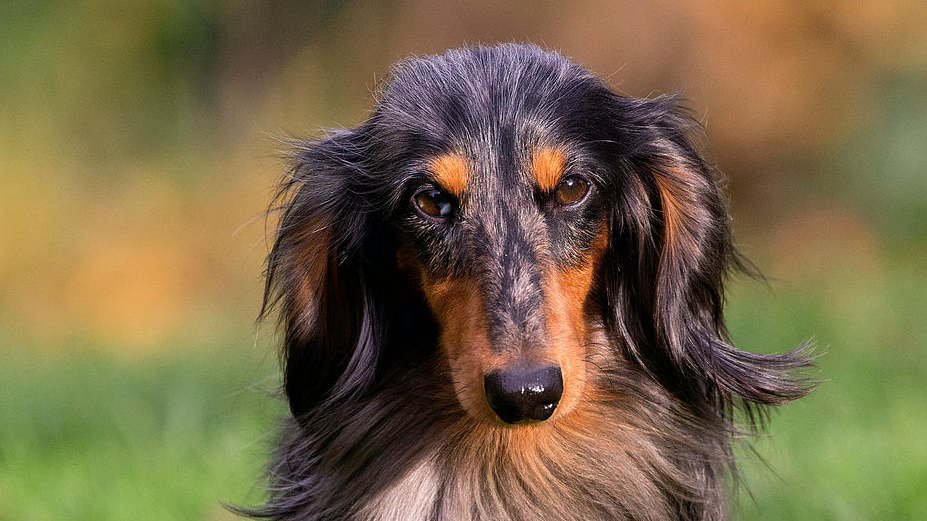
Caring for your Standard Long-Haired Dachshund
Grooming, training and exercise tips
A natural-born athlete, the Standard Long-Haired Dachshund needs to keep up their vigorous training routine! A robust body and high energy equates to needing as much exercise as the next dog. Twice-daily walks are recommended but never long jogs; Standard Long-Haired Dachshund and running do not mix. A fenced-in yard is enough to give this breed room to run to their heart’s content. Dachshunds are not suited to jumping. Their elongated back can be fragile with shorter legs beneath and a jarring movement from on high could put them in serious peril.
The Standard Long-Haired Dachshund is known for their short and sleek coat, which is typically very shiny if cared for properly. Twice-weekly brushing of your Dachshund should keep them groomed sufficiently and bathe only when needed to keep the coat in good shape. Nail trims are recommended once or twice per month. Teeth should be brushed, however, at least two to three times a week, daily if you can get away with it.
Despite being known for their persistent manner, Standard Long-Haired Dachshunds are very easy to train, especially as a dog that finds solace in bonding with one person. Their sporting background has trained the breed as a digger, terrier, and scrubber, so training should be early and firm; since they’re strong-willed, patience is your friend! Standard Long-Haired Dachshund traits include courage and boldness so they’ll need to know who is in charge. Independence is a plus but make sure they don’t wander off as a result. Dachshunds normally get along with other dogs and cats in the house but may at times feel the need to dominate the situation.
A natural-born athlete, the Standard Long-Haired Dachshund needs to keep up their vigorous training routine! A robust body and high energy equates to needing as much exercise as the next dog. Twice-daily walks are recommended but never long jogs; Standard Long-Haired Dachshund and running do not mix. A fenced-in yard is enough to give this breed room to run to their heart’s content. Dachshunds are not suited to jumping. Their elongated back can be fragile with shorter legs beneath and a jarring movement from on high could put them in serious peril.
The Standard Long-Haired Dachshund is known for their short and sleek coat, which is typically very shiny if cared for properly. Twice-weekly brushing of your Dachshund should keep them groomed sufficiently and bathe only when needed to keep the coat in good shape. Nail trims are recommended once or twice per month. Teeth should be brushed, however, at least two to three times a week, daily if you can get away with it.
Despite being known for their persistent manner, Standard Long-Haired Dachshunds are very easy to train, especially as a dog that finds solace in bonding with one person. Their sporting background has trained the breed as a digger, terrier, and scrubber, so training should be early and firm; since they’re strong-willed, patience is your friend! Standard Long-Haired Dachshund traits include courage and boldness so they’ll need to know who is in charge. Independence is a plus but make sure they don’t wander off as a result. Dachshunds normally get along with other dogs and cats in the house but may at times feel the need to dominate the situation.
All about Standard Long-Haired Dachshunds
The Standard Long-Haired Dachshund is one of three varieties of the distinctive long-bodied and charming dog, one of the most popular breeds there is. Dachshunds can also be Smooth-Haired and Wire-Haired, with all other characteristics remaining the same, save for their coat and their many colorings. The breed is known to be lively and playful but also to need solid companionship, attaching easily to one person as well as to their family.
Their long and very shiny coat is a great choice but the breed is in an almost permanent state of moult, or shedding of the old coat to make way for the new. Not to worry: It won’t come out in clumps but in miniscule amounts each day. Brushing your Dachshund must be consistent then, but once a day or every other should work.
Read more on this topic
Sources
- Veterinary Centers of America https://vcahospitals.com/
- Royal Canin Dog Encyclopaedia. Ed 2010 e 2020
- Banfield Pet Hospital https://www.banfield.com/
- Royal Canin BHN Product Book
- American Kennel Club https://www.akc.org/
Like & share this page